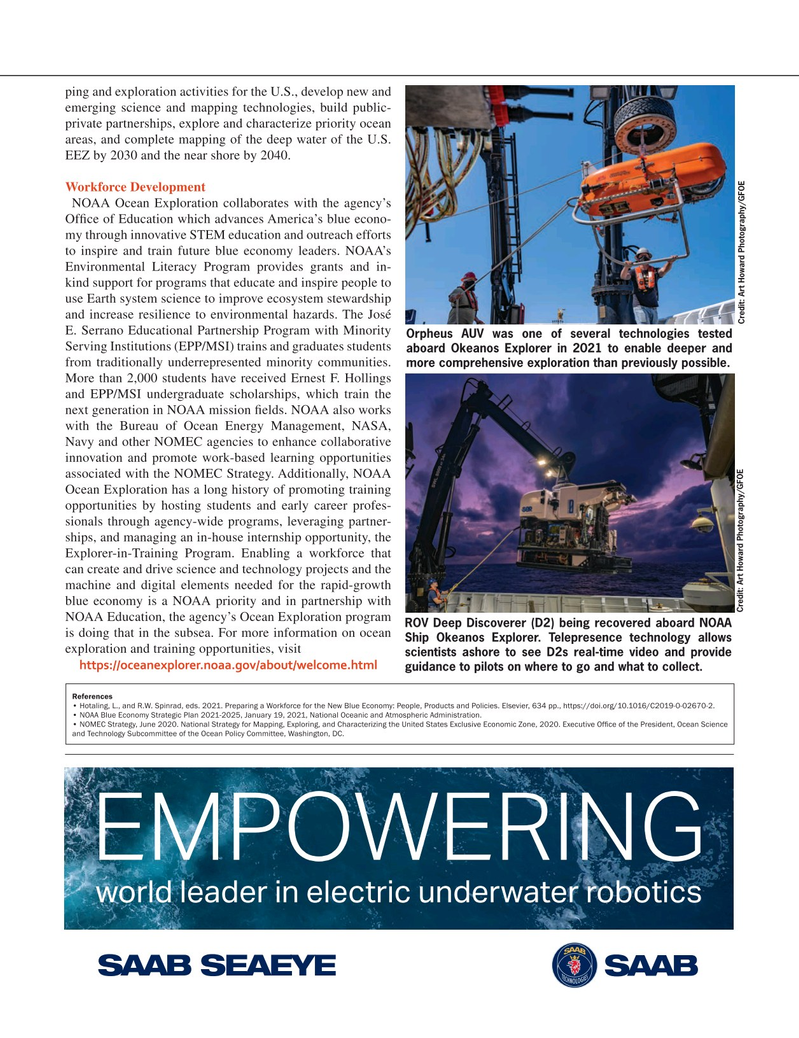
Page 35: of Marine Technology Magazine (September 2021)
MTR100: Focus on 100 Leading Companies, People and Innovations in the Subsea Space
Read this page in Pdf, Flash or Html5 edition of September 2021 Marine Technology Magazine
ping and exploration activities for the U.S., develop new and emerging science and mapping technologies, build public- private partnerships, explore and characterize priority ocean areas, and complete mapping of the deep water of the U.S.
EEZ by 2030 and the near shore by 2040.
Workforce Development
NOAA Ocean Exploration collaborates with the agency’s
Of? ce of Education which advances America’s blue econo- my through innovative STEM education and outreach efforts to inspire and train future blue economy leaders. NOAA’s
Environmental Literacy Program provides grants and in- kind support for programs that educate and inspire people to use Earth system science to improve ecosystem stewardship and increase resilience to environmental hazards. The José
Credit: Art Howard Photography/GFOE
E. Serrano Educational Partnership Program with Minority
Orpheus AUV was one of several technologies tested
Serving Institutions (EPP/MSI) trains and graduates students aboard Okeanos Explorer in 2021 to enable deeper and from traditionally underrepresented minority communities. more comprehensive exploration than previously possible.
More than 2,000 students have received Ernest F. Hollings and EPP/MSI undergraduate scholarships, which train the next generation in NOAA mission ? elds. NOAA also works with the Bureau of Ocean Energy Management, NASA,
Navy and other NOMEC agencies to enhance collaborative innovation and promote work-based learning opportunities associated with the NOMEC Strategy. Additionally, NOAA
Ocean Exploration has a long history of promoting training opportunities by hosting students and early career profes- sionals through agency-wide programs, leveraging partner- ships, and managing an in-house internship opportunity, the
Explorer-in-Training Program. Enabling a workforce that can create and drive science and technology projects and the machine and digital elements needed for the rapid-growth blue economy is a NOAA priority and in partnership with
Credit: Art Howard Photography/GFOE
NOAA Education, the agency’s Ocean Exploration program
ROV Deep Discoverer (D2) being recovered aboard NOAA is doing that in the subsea. For more information on ocean
Ship Okeanos Explorer. Telepresence technology allows exploration and training opportunities, visit scientists ashore to see D2s real-time video and provide https://oceanexplorer.noaa.gov/about/welcome.html guidance to pilots on where to go and what to collect.
References • Hotaling, L., and R.W. Spinrad, eds. 2021. Preparing a Workforce for the New Blue Economy: People, Products and Policies. Elsevier, 634 pp., https://doi.org/10.1016/C2019-0-02670-2. • NOAA Blue Economy Strategic Plan 2021-2025, January 19, 2021, National Oceanic and Atmospheric Administration.
• NOMEC Strategy, June 2020. National Strategy for Mapping, Exploring, and Characterizing the United States Exclusive Economic Zone, 2020. Executive Of? ce of the President, Ocean Science and Technology Subcommittee of the Ocean Policy Committee, Washington, DC.
EMPOWERING world leader in electric underwater robotics
MTR #7 (34-49).indd 35 9/22/2021 9:28:16 AM

 34
34

 36
36
